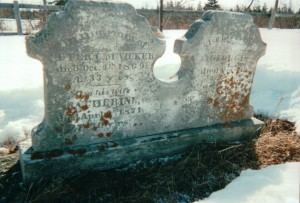 |
| Victims of the Saxby Gale |
The storm was at its heaviest in the western Bay of Fundy, striking Charlotte County, New Brunswick, in the evening. Winds of over 100 mph damaged, capsized or beached a total of 160 vessels in the Quoddy Bay area. Ten vessels went ashore between Robbinston and Eastport, Maine; seven at Eastport, and twenty-three at West Quoddy. Lloyds List of October 9 reported “Great damage was done on the 4th October by storm and high tides at New Brunswick. Eastport, Maine, was entirely destroyed”.
All around the Bay of Fundy, major damage to shipping was reported. Of the nineteen vessels at anchor at Westport harbour when the gale commenced, eleven were driven ashore and one foundered
at anchor. The Saxby Gale swept up the Memramcook Valley, propelling a storm surge that raised the tide eight feet over the dykes. Two schooners were carried over the marsh and stranded by the storm surge a half a mile from the river bank.
Shipping caught at sea in the Bay sustained damages too. A schooner belonging to Jonesport, Maine, was found after the gale, drifting on beam ends, all hands lost. Another caught out in the Bay in the gale, was badly strained, disabled and leaky; she was located by a tug and taken to Saint John for repairs. Meanwhile, the brig M. T. Ellsworth was dismasted in the Bay and later towed in, and the brig Raven was capsized off the mouth of the Bay of Fundy, losing the mate overboard.
At Saint John, a dozen ships, brigs and schooners were damaged in the gale, some pounded at the wharves, others broken away and were driven ashore and smashed up. The upper works was blown off of the steamer Fawn in Saint John River.
The new, 500-ton barque Genii had arrived at New River on Saturday morning, October 2, to load deals for Liverpool. When the Saxby Gale struck on Monday, some of the crew were ashore, but seven stevedores from Mascarene (near St. George) were on board to load deals. That night, in the fury of the gale, the barque broke from her anchors, struck New River Ledge broadside and rolled over, hurling all on board to their death. The new barque ended up on shore, smashed up and upside down. Lost were Captain Bayley (of Westport, Brier Island), the officers and the seven stevedores from Mascarene. The Genii had just been launched at St. Andrews only three weeks earlier.
In St. Andrews, a dozen schooners in port at the time sustained damages in the gale. The sloop Matilda was picked up by the storm surge and set on top of the wharf, high and dry.
Eastport, Maine, saw havoc along the waterfront, with several schooners smashed up and wrecked. The brig Phoebe Ellen, from Londonderry, Nova Scotia, took shelter in West Quoddy Bay as the Saxby Gale was breezing up, along with twenty-three other vessels. During the gale, several vessels’ anchors dragged and the brig was struck first by a barque, then by the schooner D. Sawyer and finally by the brig Whittier, each adding to the damage from the last. The next morning, only thirteen vessels were left at anchor, all the others had been blown ashore or sunk.
The schooner Rialto was capsized in Passamaquoddy Bay and all on board perished. Another schooner was wrecked at Deer Island and at nearby Spruce Island, the Saint John schooner Guide was totally wrecked. Meanwhile, the schooner Rio was lost at Campobello with all her crew.
The schooner Rechab, from St. Stephen, with a cargo of axes, bound for Saint John, had left St. Andrews that morning and was totally lost in Bliss Harbour [near Blacks Harbour] during the gale. Also wrecked there were the schooners Ellen McLeod and Gipsey; the schooner Rosilla B. was driven ashore there too.
At nearby Letang, a vessel went ashore and a young man was drowned, and a schooner sank at Back Bay, not far away. Up the shore, at Beaver Harbour, the schooner Ross was wrecked, three men drowned. Wrecks were strewn along the shore from Beaver Harbour, through Lepreau, Dipper Harbour and Musquash.
Grand Manan Island felt the full force of the gale. The light keeper at Gannet Rock Light, Walter B. McLaughlin, noted in his journal for October 4, 1869, “. . . At Noon, wind SSE strong gale and misty. From 6 to 8 violent gale and storming with rain. At 9 wind S, the gale continues.”
Meanwhile, around Grand Manan, seven schooners were driven ashore at Flagg’s Cove (North Head) and two schooners went ashore at Pettes’ Cove, where nine bodies washed ashore. Just down the shore at Bancroft Point, the schooners Leader and Romp, both belonging to Eastport, were totally lost. Parts of the wrecks of two small vessels were driven ashore between Grand Harbour and Seal Cove; the crews supposed lost. Just off of Grand Manan, in Three Island Harbour, another schooner was totally lost.
Certainly the Saxby Gale was one of those storms that made a lasting impression on all who witnessed the awesome power of a raging wind. It was the stuff of legend and to this day stories are told of that eventful day and the powerful acts of nature both along the shore and on the water.
More information is at: https://alchetron.com/1869-Saxby-Gale#-
No comments:
Post a Comment